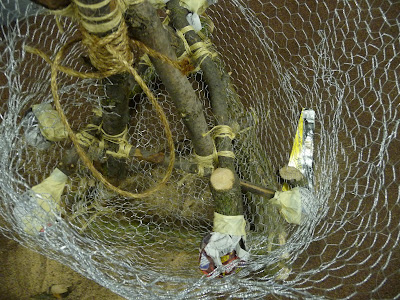
branches on the passenger's side

branches in the front yard

handsaw, twine, & chicken wire

lashing together the armature's base

the armature coming together

the armature in the hallway

the armature from above

trimming the base

shaping the chicken wire

onion mesh shape

wire onion from above

onion, papier-mached

the onion from above

strips of ripped comics & ads

putting on the first layer of paint

close up of onion shoots

the end of a shoot

the onion from above
IS IT AN ONION, OR IS IT GARLIC?
It took a while trying to figure out how the onion would come together. One problem comes from the dispute over the origin of the name Chicago. Some historians think Chicago is derived from the Native American word for onion, whereas others think the name refers to marsh garlic. There is no consensus as to which Native American tribe originated the word on which the name Chicago is derived -- from Potawatomi, Miami-Illinois, or another Native American language.
* * * *
HUNTING FOR SUPPLIES
Oil paint was out. Acrylic seemed to be the right paint to use. I went to Blick's on State St., and the people there were very helpful. They had those big boxes of mashed up papier-mache, but I decided to go "old school" and just use strips of newspaper with flour.
I wanted to figure out some way to have the "layers" be aromatic, but I wasn't sure how to do that. A friend told me about some international flavor company, and I thought about asking them if I could get some free samples. But apparently they're out of business. I bought some bottles of dill, clove, and other spices at Stanley's, and I bought some bottles of vanilla & other extracts at another grocery store.
* * * *
THE ONION'S ARMATURE
The first plan was to have the onion hang from an apparatus, and I was thinking about papier-macheing a big balloon (maybe the size of one of those large Chinese paper lanterns), but a friend suggested that it be a floor-mounted piece. That seemed more logistically feasible.
I wasn't sure what the armature should be, and I thought coat rack sawed in half, with some 2"x4"s nailed it might work. I ditched that idea, and I was thinking about bamboo. I went to Home Depot, but they didn't sell bamboo, except for those Tiki torches. Then I went to Jo-Ann Fabrics, but all they had was sharpie-thick decorative branches. It made me wish I was living in someplace where bamboo grows wild in groves. Like last December I was down in Atlanta visiting my cousins, and there was a big bamboo grove down the street from their house, with a pile of dead bamboo in a pile.
I had an epiphany while I was standing in the ornamental flowers & grass aisle at Jo-Ann Fabrics -- I'd gather some branches from some location here in Chicago. I live in Chicago's west side, and there aren't any huge tracts of woodsy areas in my vicinity, but there are some parks. I bought a hand saw, and I went to a local park. I saw a dead tree, and I sawed off some branches.
I came back to my place, and I lashed branches together with twine. The branches for the base are thicker, like logs for a fireplace. Photos of this stage of the process can be viewed here.
* * * *
THE SHAPE OF THE ONION
There's no way a papier-mache onion should or could be completely "anatomically" correct, in relation to the vegetable it's supposed to represent. The onion is pretty lumpy now. It balloons at the bottom, and it's far from symmetrical. You can see the hexagonal outlines of the chicken wire (which I think resonates serendipitously with the hexagonal shapes of the stacked SPC modules (as seen from above), as well as the bee track, which is part of the World Listening Project's "Acoustic Mirror of the World" sound installation piece). Photos of this stage of the process can be viewed here.
* * * *
THE ONION'S SHOOTS
I decided to make five shoots. Five's a good number, and I remember when I took art lessons from Peggy Ward when I was a kid, she mentioned the principle of using an odd number of items in flower arrangements, etc.
I made the shapes with coathangers. Then I cut strips of text and images from some books about gardening in the Midwest, which I bought at Myopic Books. I wove strips together, then I wrapped them around the coathanger shapes. I wrapped the ends of the coathangers around parts of the armature.
Final stages of the onion's construction can be viewed here.
No comments:
Post a Comment